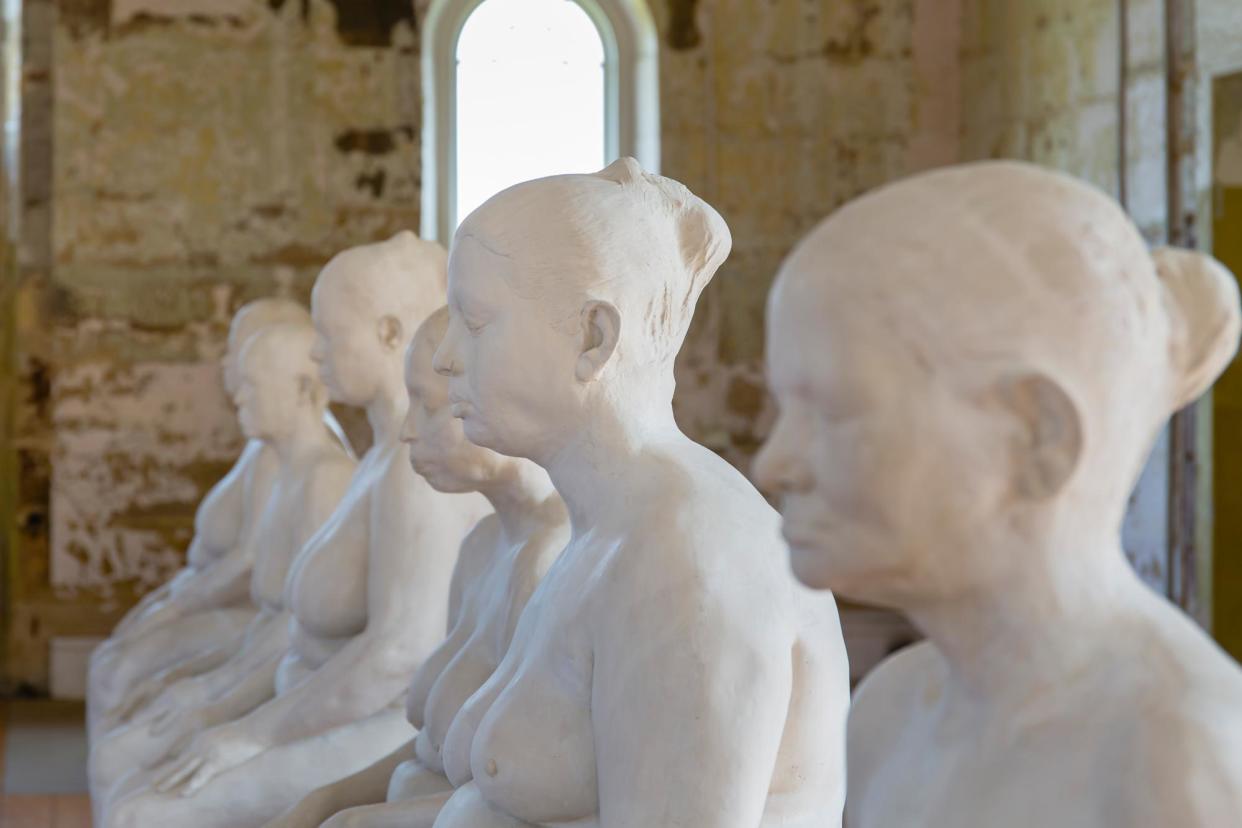‘My sculptures are alive. They dance around the gallery at night’: the viscerally spiritual art of Bharti Kher

When Bharti Kher talks about her sculptures, she gives them pronouns. For two decades, the British-born artist, who lives between Delhi and London, has been making the most startling works to investigate the female body and all of them have become characters in their own right. As she puts it, “my sculptures are alive – they run around the gallery at night when we’re all asleep.”
“I am an animist,” Kher tells me. Central to her work is the ancient belief in universal consciousness and in the potential of all material. This openness to the beyond infuses the survey show – part retrospective, part new commission – she has opened at Yorkshire Sculpture Park (YSP) near Wakefield. Taken as a whole, the exhibition describes a most restless mind.
The studio is a laboratory. We test everything and write it all down like a cookbook
Bharti Kher
Using bindis, saris, bracelets, paper, plaster, bronze, copper, steel, stone, wood, porcelain, resin, fur, wax and more, she makes things you feel with your eyes and, often, want to eat. She tells me she has 20 years’ worth of notebooks, files and scraps of paper on which she’s recorded the methods used for everything from papier-mache to heating systems – whatever any particular work has called for. “The studio is a laboratory. If we start with a new material, we do exhibit A, exhibit B, exhibit C, exhibit Z, we test it in the monsoon, in the summer, in the winter and we write it all down – like a cookbook.”
An erudite constellation of references – philosophical, literary, scientific, religious – run through and spin out of all that Kher makes. See the two cubic installations set to occupy gallery one. Both stand nearly 3m tall. The first is a block made of salvaged Victorian-style radiators, the second, a room you can enter, built of glass bricks and clay. In their blunt minimalist form, these pieces would be reminiscent of a pair of Donald Judds, say, were it not for the rich seam of geopolitical and socioeconomic concerns that come with their titles, respectively The Hot Winds That Blow from the West, and the Deaf Room.
So too, Virus, the iterative monochromatic spiral of large bindis that Kher has been making, one a year, since 2010 and is set to complete in 2039. The version she has made for YSP is bright sunset yellow. So far, so pretty. Ask her what the series about though, and the neatness dissipates: Kher talks about history, astronomy, science, quantum physics, neurology, religion, and studies in consciousness, before adding, “And all we’ve sort of come to realise in the end is that every single human being owes nature a death.”
The newest works in Yorkshire include a giant bronze, called Djinn. He, for it is a he, resembles a small boy being a tree. He has a head of bananas and he stands, 5m tall, on a hill at the northern most point of the park where the sun will light him as it sets and rises and the seasons will alter his patina.
Women are underrepresented in sculpture, particularly outdoor, public works. With her bodies divided, her exploding heads, Kher refuses to be put in a box. Her focus is always on the multiplicity - the universes, even – - that every woman contains. “There’s a lot of rigidity around who we are, what we are, how we function, what we do, where we sit, where we don’t sit. My works is always pushing against that.”
Five essential works by Bharti Kher
Six Women, 2013–2015 (main image)
By 2012, Kher had deconstructed the body every which way, when suddenly she realised she’d never seen a sculpture of a woman sitting on a chair, just being – her body a repository of meaning and memory. As Kher puts it: “It’s very quiet but also really loud.”
And All the While the Benevolent Slept, 2008
Chhinnamasta, the creator and destroyer of all things, this crouching figure holds in one hand a teacup and saucer and in the other, an ape’s head, its mouth agape. Her own head is replaced by a splayed bundle of copper wires, their lengths reaching out towards the edges of everything.
Bloodline, 2000
Kher adapts this glowing red line of glass bangles, lit from within, to the dimensions of whichever spaces she’s showing in. Though it is usually vertical, at YSP she has used 30,000 bracelets to build it on the horizontal. It runs the full length of the gallery concourse, a delicate artery of coloured light, hovering just above head height.
The Hybrid series: The Hunter and the Prophet, 2004
The carcass on the ground references a myth Kher loves, wherein the hunter puts the eye of the hyena under his tongue, to receive the gift of prophecy. Kher wanted her hero to be female. “I was creating my own mythologies.”
Ancestor, 2022
When Kher was asked to make something for New York’s Central Park, she’d had long Covid for some time. She says she felt in need of the ur-woman, the archetypal mother. Cue this outsized carer – a simple work, to Kher’s mind – with 23 heads in her chest, so many outsiders now embraced.
Bharti Kher: Alchemies is at Yorkshire Sculpture Park, near Wakefield, to 27 April 2025.


